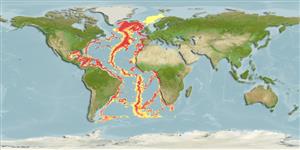Klassifizierung / Names
Namen | Synonyme | Catalog of Fishes(Gattung, Arten) | ITIS | CoL | WoRMS | Cloffa
>
Ophidiiformes (Cusk eels) >
Ophidiidae (Cusk-eels) > Neobythitinae
Etymology: Penopus: Greek, penia, -as, penomai = poverty + Greek, pous = feet.
More on author: Vaillant.
Environment: milieu / climate zone / depth range / distribution range
Ökologie
seewasser bathydemersal; tiefenbereich 960 - 3535 m (Ref. 34024). Deep-water
Western Atlantic: from 38°29'030''N, 70°57'W (holotype of P. macdonaldi) southwards through the Gulf of Mexico to 22°45.7'S, 40°19.6'W. East Atlantic: from 34°28'N, 7°43'W southwards through the Gulf of Guinea to 36°06'S, 19°33'E.
Size / Gewicht / Alter
Maturity: Lm ? range ? - ? cm
Max length : 35.0 cm TL Männchen/unbestimmt; (Ref. 4103)
Rückenflossenstacheln (insgesamt): 0; Rückenflossenweichstrahlen (insgesamt): 135-158; Afterflossenstacheln 0; Afterflossenweichstrahlen: 106 - 122; Wirbelzahl: 77 - 83. Penopus microphthalmus differs from P. japonicus by the following characters: has a higher number of dorsal, 135-158 (vs. 117) and anal, 106-122 (vs. 89) fin rays; lower number of preopercular spines, 4-7 (vs. 9); indistinct spine behind the posterior nostril (vs. distinct, 1% SL); by the bigger horizontal diameter of the eye 1.1-1.6% SL (vs. 0.8); and in having an almost fully scaled head (vs. squamation of the head restricted to the middle part of the preopercle) (Ref. 87601).
Rare species (Ref. 34024). Oviparous, with oval pelagic eggs floating in a gelatinous mass (Ref. 205).
Life cycle and mating behavior
Geschlechtsreife | Fortpflanzung | Ablaichen | Eier | Fecundity | Larven
Nielsen, J.G. and S. Ohashi, 2011. A new species of Penopus (Teleostei: Ophidiidae) from the Ryukyu Trench, the West Pacific, with remarks on Penopus microphthalmus. Ichthyol. Res. 58(3):232-237. (Ref. 87601)
IUCN Rote Liste Status (Ref. 130435)
Bedrohung für Menschen
Harmless
Nutzung durch Menschen
Fischereien: nicht kommerziell
Mehr Information
NamenSynonymeMetabolismusRäuberÖkotoxikologieFortpflanzungGeschlechtsreifeAblaichenSpawning aggregationFecundityEierEientwicklung
Alter/GrößeWachstumLänge-GewichtLänge-LängeLängenhäufigkeitenMorphometrieMorphologieLarvenLarven Pop.Dyn.RekrutierungDichteBRUVS
ReferenzenAquakulturAquakultur ProfilZuchtlinienGenetikElectrophoresesVererbbarkeitKrankheitenVerarbeitungNutrientsMass conversion
Tools
Zusatzinformationen
Download XML
Internet Quellen
Estimates based on models
Preferred temperature (Ref.
123201): 2.2 - 5.1, mean 3.9 °C (based on 844 cells).
Phylogenetic diversity index (Ref.
82804): PD
50 = 0.7500 [Uniqueness, from 0.5 = low to 2.0 = high].
Bayesian length-weight: a=0.00110 (0.00041 - 0.00296), b=3.08 (2.85 - 3.31), in cm total length, based on LWR estimates for this (Sub)family-body shape (Ref.
93245).
Trophic level (Ref.
69278): 3.6 ±0.6 se; based on size and trophs of closest relatives
Widerstandsfähigkeit (Ref.
120179): mittel, Verdopplung der Population dauert 1,4 - 4,4 Jahre. (Preliminary K or Fecundity.).
Fishing Vulnerability (Ref.
59153): Low vulnerability (25 of 100).
